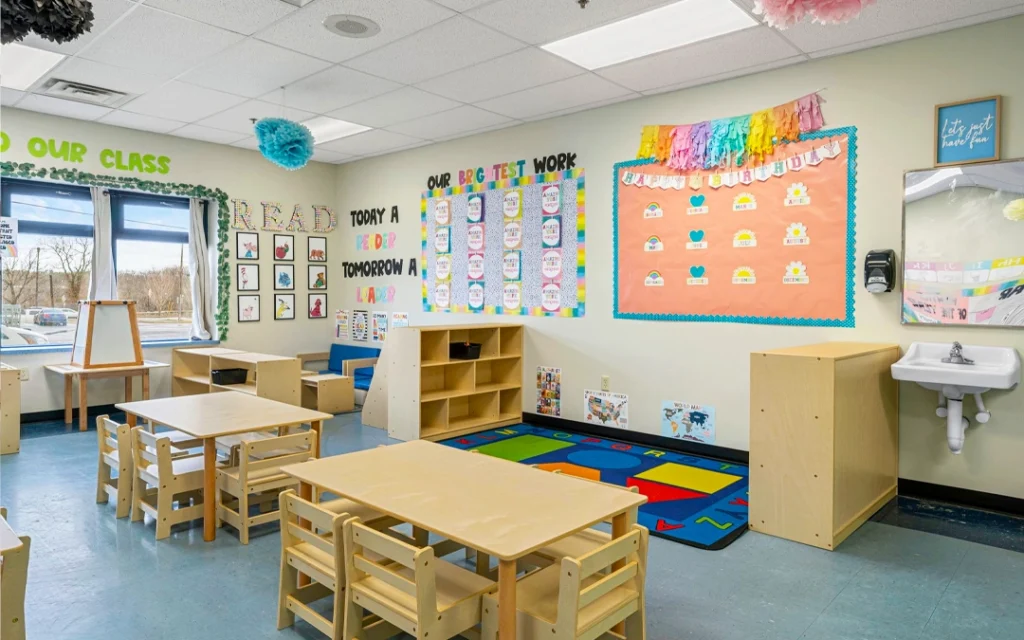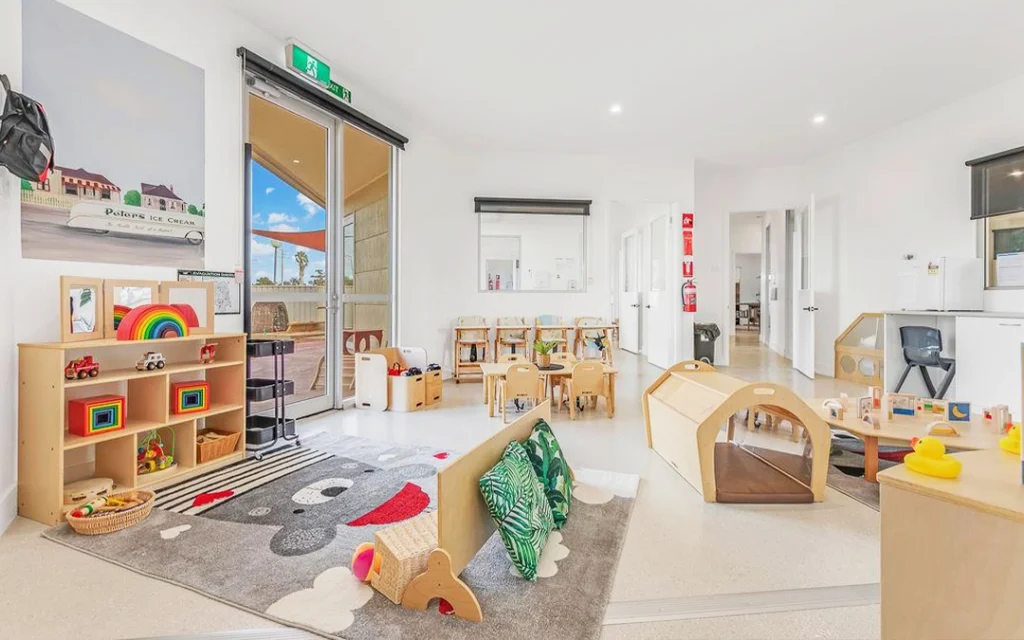Are you looking to start a daycare business but unsure where to begin? With the increasing demand for quality childcare and early education, launching a daycare in 2025 might seem like a promising idea, but how do you ensure success? What steps should you take to create a business plan that attracts parents, meets legal requirements, and keeps your daycare thriving? Without the right guidance, you might find yourself overwhelmed by the many moving parts involved in running a daycare business.
Creating a daycare business plan is crucial to overcoming the challenges of starting and growing a daycare. A solid business plan gives you clear direction and allows you to navigate the complexities of running a daycare. With a well-structured plan in place, you can outline the services you’ll offer, identify your target market, and set realistic financial goals. A good business plan will also ensure you’re compliant with all legal requirements, allowing you to focus on providing quality care.
This guide will walk you through each step needed to create a successful daycare business plan, from understanding your market and securing funding to building a strong team and marketing your services. By the end, you’ll be equipped with a strategy to launch your daycare confidently.
Is Starting a Daycare Business in 2025 a Good Idea? How to Make It Profitable
Starting a daycare business can be a highly rewarding venture, but is it a smart investment in 2025? The daycare industry continues to grow as more parents enter the workforce and the demand for early childhood education rises. The pandemic has reshaped how families view childcare, with parents becoming more conscious of health, safety, and the quality of care their children receive. As a result, 2025 presents a unique opportunity for daycare businesses that can adapt to these new trends.

Market Trends in 2025
In 2025, the daycare industry is benefiting from several key trends, making it a promising field for new business owners:
- Increased demand for child care services: As more parents return to work, daycare centers remain essential, with many parents seeking quality, flexible care options.
- Focus on early childhood education: Parents are more interested in daycare providers that offer early learning programs, making education a key differentiator.
- Health and safety awareness: The COVID-19 pandemic has increased demand for daycare facilities that prioritize hygiene and safety.
How Daycares Can Make Money in 2025
The daycare business can be profitable if you take a strategic approach to operations, pricing, and service offerings. Here are a few ways to boost your daycare’s profitability:
- Offer specialized services: Consider offering additional services such as after-school programs, summer camps, or enrichment activities.
- Implement tiered pricing: Create different pricing tiers for families based on their needs (e.g., part-time, full-time, extended hours).
- Optimize facility usage: Maximize your facility’s space by offering flexible hours or expanding into evening or weekend care.
- Leverage technology: Use management software to streamline operations, reduce administrative costs, and improve customer service.
- Partner with local businesses: Collaborate with companies that support working parents, such as offering childcare services as a benefit.
In the next step, we will dive deeper into Step 1: Market Research and Analysis for Daycare Businesses, where we’ll explore the key components of understanding your market and analyzing competition to set the stage for a successful daycare business plan.
Step 1: Market Research and Analysis for Daycare Businesses
Starting a daycare business is not just about passion—it’s about understanding the market, the needs of your community, and how to position your daycare center within that space. Market research is the backbone of your daycare business plan because it provides the insight you need to make informed decisions about pricing, services, and competition. By analyzing these key areas, you can ensure that your daycare business plan is not only competitive but also sustainable in the long term.

Identifying Your Target Market
Your target market defines who you will be serving and should be the first step in your daycare business plan. For daycare businesses, your target market will likely include parents of children ranging from newborns to early school-age children. Understanding your target demographic—such as parents’ work schedules, their income levels, and their childcare needs—is essential.
- Who are your ideal customers?
- Are they working parents needing full-day care?
- Do they have flexible schedules and prefer part-time care?
- Are they looking for specialized programs (such as early childhood education, special needs services, etc.)?
Knowing your target market will help you better define your daycare business plan’s offerings and make sure you’re meeting the needs of parents in your area.
Analyzing Local Competition
When crafting your daycare business plan, one of the most important steps is conducting a competitive analysis. Knowing who your competitors are and understanding what they offer can give you the insight needed to differentiate your daycare and attract clients.
- Key questions to ask:
- How many daycare centers are in your area? What types of services do they offer?
- What are their pricing structures? Are they affordable or premium?
- What are the strengths and weaknesses of their businesses?
- How do parents perceive them—what do reviews or surveys say?
Understanding your competition helps you identify gaps in the market where your daycare business can excel. Whether it’s offering higher-quality childcare, specialized programs, or flexible hours, knowing what sets you apart is critical to your success.
Understanding Market Demand and Trends
The next critical aspect of your market research is understanding the demand for daycare services and the trends affecting the industry. Childcare demand is influenced by many factors, such as economic conditions, birth rates, and societal trends like working parents or changes in family structures.
- Key trends to consider:
- Working parents: More parents are entering the workforce and relying on daycare centers for child care.
- Early childhood education: Many parents are seeking early educational programs for their children, even at the daycare level.
- Health and safety: Parents are becoming more conscious of safety, hygiene, and staff qualifications, especially in the wake of health crises like the COVID-19 pandemic.
Researching and understanding these trends will help you build a daycare business plan that addresses both current and future market needs. Additionally, you can better tailor your services to align with what parents are increasingly seeking in a daycare provider.
Pricing and Revenue Projections
Once you’ve identified your target market and competition, it’s time to determine how much to charge for your daycare services. Your pricing structure is a vital element of your daycare business plan and should be based on thorough market research. Factors to consider include:
- The average cost of daycare services in your local area.
- The value proposition your daycare offers—do you provide premium services, flexible hours, or a unique curriculum?
- Local economic conditions and parents’ willingness to pay.
By analyzing your competitors’ pricing models, you can position your daycare’s pricing to ensure profitability while still remaining competitive in your area.
- Revenue Projections: In your daycare business plan, include detailed revenue projections. Consider the following variables:
- Enrollment capacity: How many children can your daycare accommodate?
- Average tuition: What is the average amount each family will pay per month?
- Additional income streams: Will you offer add-on services like extended hours, meals, or special educational programs?
Using SWOT Analysis for Market Insights
A SWOT analysis (Strengths, Weaknesses, Opportunities, and Threats) is a useful tool in market research to better understand your daycare business and its position within the local market. By evaluating these areas, you can make more informed decisions.
- Strengths:
- What unique features set your daycare apart from competitors? Perhaps it’s your staff qualifications, flexible hours, or specialized programs.
- Weaknesses:
- Are there any potential weaknesses you need to address in your daycare business plan? For example, do you lack space or experience?
- Opportunities:
- Look for emerging trends in the market that your daycare could capitalize on. For instance, many parents are looking for eco-friendly childcare solutions.
- Threats:
- Consider potential threats such as increased competition or changes in government regulations that could affect your daycare’s operations.
By conducting thorough market research and analysis, you will be equipped to create a daycare business plan that’s informed by real data and positioned for long-term success.
Step 2: Crafting the Vision and Mission Statement
Creating a clear vision and mission statement is a crucial part of your daycare business plan. It helps define your daycare’s core values and establishes the direction for all your efforts. Your vision statement reflects the future aspirations of your daycare, while the mission statement articulates the day-to-day purpose of your business.

Crafting Your Vision Statement
A vision statement is a forward-thinking declaration that helps align your daycare’s growth with long-term objectives. It should inspire both staff and parents and give them a sense of the impact your daycare aims to make. When crafting your vision, consider the following:
- What kind of legacy do you want your daycare to leave?
- How will your daycare impact the community?
- What do you want your daycare to be known for?
Your vision statement should be succinct but powerful, motivating others to rally behind your mission. For example, a vision statement might be: “To provide a nurturing, innovative, and inclusive environment where every child’s potential is recognized and supported.”
Crafting Your Mission Statement
A mission statement is more grounded in the present. It communicates the core purpose of your daycare, its values, and how it delivers services on a daily basis. It should explain who you serve, what you do, and why it matters. Consider these questions when developing your mission statement:
- Who are your key customers (children and their families)?
- What services do you offer, and how do you provide them?
- What values guide your daycare’s operations?
A good mission statement should be clear, concise, and action-oriented. For example: “Our mission is to provide high-quality, affordable child care that fosters creativity, emotional growth, and academic readiness in a safe and supportive environment.”
Aligning Your Vision and Mission with Market Needs
Once you’ve crafted both your vision and mission statements, make sure they align with the needs of your target market. A strong daycare business plan is one that connects your goals with the demands of your community. Ensure that your vision reflects the aspirations of the parents you want to serve and that your mission addresses the needs of the children in your care.
By crafting a clear and compelling vision and mission, you not only define your daycare’s purpose, but you also set the stage for building a successful, sustainable business that resonates with both parents and staff.
Step 3: Defining Services and Offerings: Types of Daycare Programs
Defining the services and offerings of your daycare is a crucial step in your daycare business plan. The type of services you offer will directly impact your target market, pricing strategy, and competitive positioning. Daycare centers can provide various programs based on the needs of the community and the age group of children. Understanding the different types of daycare services will help you determine what works best for your business.
Full-time vs. Part-time Care
One of the first decisions to make is whether you will offer full-time care, part-time care, or a combination of both. Full-time daycare provides care for children during working hours, usually 5 days a week. It’s a reliable service for working parents who need daily child care. Part-time daycare, on the other hand, might offer care for fewer days or hours each week, making it more flexible for parents who don’t need full-time services.
- Full-time care: This is the most common service, offering care throughout the day during typical business hours (e.g., 8 AM to 6 PM). It’s ideal for parents with full-time jobs who need consistent childcare every weekday.
- Part-time care: This type of care allows for more flexibility. Parents may choose part-time care for various reasons, such as having a non-traditional work schedule or needing daycare for a few hours during the day.
Both full-time and part-time care have their advantages, but understanding the preferences of your target market will help you decide which option is best for your daycare business plan.
Early Childhood Education and Specialized Programs
In 2025, parents are increasingly looking for daycare centers that offer more than just basic childcare. They want their children to engage in early learning programs that foster development and academic readiness. Many daycare centers offer specialized programs such as early childhood education, language development, and emotional growth.
- Early childhood education programs: These programs focus on teaching children foundational skills in subjects like math, reading, and science through engaging activities.
- Specialized programs: These might include art, music, language development, special needs care, or STEM (science, technology, engineering, and math) programs.
Adding these programs to your offerings can differentiate your daycare from competitors and provide added value to parents seeking more than just basic daycare.
Creating a Pricing Strategy for Your Services
Pricing is one of the most important elements of your daycare business plan. Your pricing strategy should be competitive and aligned with the value you offer. It’s essential to set your pricing based on your location, target market, and services provided. Here are a few considerations when developing your pricing strategy:
- Analyze local competitors: Research what other daycare centers in your area are charging and determine where you can position your pricing.
- Account for your costs: Make sure to include all costs such as staff salaries, facility maintenance, insurance, and educational materials when setting prices.
- Offer tiered pricing: Consider offering different pricing tiers based on the services provided. For example, you could charge a premium for specialized programs or extended hours.
- Create discounts and packages: Offering discounts for siblings or creating packages for families who need part-time or flexible care can make your daycare more attractive.
Offering Flexible Hours and Additional Services
In 2025, parents are looking for more flexible daycare solutions to fit their schedules. Offering flexible hours or additional services like extended care, after-school programs, or weekend care can increase your daycare’s appeal. Here are some ways to add flexibility to your services:
- Extended hours: Some parents may need childcare outside of typical business hours. By offering extended care in the evenings or on weekends, you can accommodate more families.
- After-school programs: These programs provide care for older children who may not need full-time daycare but still require supervision after school.
- Summer programs: Offering special summer camps or educational activities during school breaks can attract more clients.
By offering flexible care options, you make your daycare center more accessible to a wider range of families, which in turn increases your chances of success.
Aligning Your Services with Your Daycare Business Plan
It’s crucial that the services and offerings you define align with the goals of your daycare business plan. Understanding what your target market wants, what your competitors are offering, and how you can differentiate yourself will help you craft a daycare business plan that sets you up for long-term success.
In the next step, we will focus on the financial aspects of your daycare business plan, including budgeting, funding, and revenue projections.
Step 4: Financial Planning: Budgeting, Funding, and Financial Projections
Financial planning is one of the most critical elements of your daycare business plan. Without proper budgeting, funding, and financial projections, it can be difficult to understand your daycare’s financial health, secure funding, and plan for future growth. Let’s explore how to develop a financial plan that will support the sustainability and success of your daycare business.

Setting Up Your Budget
Before you start generating revenue, you need to understand your costs. Setting up a budget allows you to manage your finances effectively, ensuring that you can cover your day-to-day expenses and plan for future investments. Key budget categories to consider include:
- Fixed costs: These include rent, utilities, insurance, salaries, and any other recurring costs.
- Variable costs: These include expenses that fluctuate, such as materials, food, and other supplies.
- Contingency fund: It’s always a good idea to have a reserve fund for unexpected costs.
Finding Funding for Your Daycare Business
Once you have a solid budget in place, you may need to secure funding to cover startup costs and operating expenses. There are several options to consider when looking for funding:
- Personal savings: If you have the financial means, using personal savings can be an effective way to get started without owing money to anyone.
- Bank loans: If you don’t have enough personal savings, you may want to explore business loans from banks or other financial institutions. Be sure to have a solid daycare business plan to show potential lenders.
- Grants and subsidies: Some government programs offer grants or subsidies to businesses in the childcare sector, so be sure to research what might be available in your area.
- Investors: You may be able to secure investors who are willing to fund your daycare business in exchange for equity or a return on investment.
Revenue Projections and Financial Sustainability
Accurate financial projections are key to understanding whether your daycare business will be profitable in the long run. This includes estimating your revenue, tracking costs, and forecasting your financial performance over time.
- Revenue projections: Estimate how much you expect to earn each month based on factors like tuition, the number of children enrolled, and any additional services you offer.
- Profit margins: Determine your expected profit margins by subtracting your projected expenses from your projected revenue.
- Breakeven point: Identify the point at which your revenue will cover all your costs, and you begin generating profits.
Managing Cash Flow
Effective cash flow management is essential for any daycare business. Cash flow refers to the movement of money in and out of your business. Positive cash flow means you have enough funds to pay bills and reinvest in your business. Negative cash flow means you are spending more than you are earning. To manage cash flow:
- Track expenses: Keep an eye on both fixed and variable costs to make sure you are not overspending.
- Invoicing and payments: Implement clear billing policies for parents to ensure timely payments.
- Reinvesting in your daycare: Consider setting aside funds for future growth, such as improving your facilities or adding new programs.
Planning for Growth and Expansion
Once your daycare is up and running and you’ve established a stable revenue stream, it’s time to start planning for growth. Here are a few strategies to consider:
- Increasing enrollment: Look for ways to attract more families, such as offering additional services or increasing your marketing efforts.
- Expanding services: Consider adding after-school programs, summer camps, or additional educational offerings to increase revenue.
- Franchising or multiple locations: If your business is successful, you may want to consider expanding to other locations or even franchising.
By developing a solid daycare business plan and financial plan, you can ensure your daycare business has the resources to thrive in the competitive childcare industry. In the next step, we will focus on Location and Facility Setup, where we’ll discuss how to choose the best location for your daycare and how to design your facilities to support your business goals.
Step 5: Location and Facility Setup: Creating the Ideal Daycare Environment
Location and facility setup are crucial elements of your daycare business plan. The environment you create plays a significant role in attracting clients and providing a safe, nurturing space for children. In this step, we’ll explore how to select the best location for your daycare, how to design your facilities for maximum efficiency, and how to align your setup with your daycare business plan.

Choosing the Right Location
The location of your daycare is vital to its success. A good location should be convenient for parents and accessible to the community, with a safe and welcoming environment for children. Here are a few factors to consider when choosing a location:
- Proximity to residential areas: Look for a location near where your target market lives. The closer you are to parents, the more convenient your daycare business plan will be.
- Accessibility: Ensure the location is easy to reach by car or public transport. Parents should find it simple to drop off and pick up their children.
- Safety and security: Ensure that the area around your daycare is safe for children. Consider factors like traffic patterns, nearby parks, and the overall neighborhood safety.
- Zoning and regulations: Confirm that your chosen location complies with local zoning laws and regulations for daycare facilities.
Designing Your Facility
Once you’ve selected your location, the next step is designing your daycare facility to meet your needs and the needs of the children in your care. Your facility should be child-friendly, functional, and safe. Here are some design considerations:
- Child-friendly spaces: Ensure your facility is designed with children in mind. Create separate play areas, learning spaces, and quiet zones. Furniture and toys should be age-appropriate and safe for children. XIHA Furniture offers a wide range of safe, durable, and child-friendly furniture that fits the needs of daycare environments, from comfortable seating to educational toys and accessories.
- Safety features: Install safety measures such as childproof locks, gates, fire exits, and non-slip flooring. Ensure your daycare facility meets all local safety regulations.
- Space for staff: Make sure there is enough space for staff to work comfortably and efficiently. Consider staff rooms, storage areas for supplies, and workstations for administrative tasks.
- Outdoor space: If possible, incorporate an outdoor play area where children can enjoy physical activity and connect with nature.
Aligning Your Facility with Your Daycare Business Plan
The design and setup of your daycare should align with your daycare business plan. Whether you’re offering full-time care, specialized programs, or after-school services, your facility should support your service offerings. Consider the following:
- Efficiency: Layout your space to allow smooth transitions between different activities. The design should support easy supervision of children, staff interactions, and service flow.
- Capacity: Make sure your space can accommodate the number of children you plan to serve while maintaining a comfortable and non-crowded environment.
- Branding: The physical space should reflect your daycare’s mission and values. A welcoming and positive atmosphere will reinforce your brand and help attract clients.
Budgeting for Location and Facility Setup
Your daycare facility is one of your most significant investments, so it’s important to plan your budget carefully. Consider the following when budgeting for location and setup:
- Lease or purchase costs: Consider whether you will lease or purchase the property and calculate the associated costs.
- Renovations and furnishings: Budget for any renovations or modifications needed to make the space suitable for your daycare operations.
- Equipment and supplies: Factor in the cost of child-friendly furniture, toys, educational materials, and safety equipment. XIHA Furniture provides a variety of affordable yet high-quality furniture solutions that fit perfectly in daycare environments.
By carefully selecting your location and designing a facility that meets your daycare’s needs, you can create an environment that is both functional and welcoming, ensuring a great experience for both parents and children.
In the next step, we will focus on staffing your daycare, including hiring qualified personnel and training your staff to ensure a high level of care.
Step 6: Staffing and Hiring: Building a Great Team
A successful daycare business is built on the strength of its team. Staffing is one of the most important elements of your daycare business plan. The team you hire will be responsible for creating a safe, nurturing, and educational environment for the children in your care. In this step, we’ll cover how to hire the right staff, develop effective training programs, and create a positive work culture to ensure the success of your daycare business.
Hiring Qualified Personnel
The first step in building a great team is hiring qualified personnel. When hiring for your daycare, you need to consider the following factors:
- Qualifications and experience: Look for staff members who have the necessary qualifications, such as early childhood education certifications, experience working with children, and background checks. The right qualifications will ensure that your daycare business plan meets the required standards for care and education.
- Passion for childcare: Beyond qualifications, you want staff who are passionate about working with children and creating a positive learning environment. Staff who are genuinely interested in early childhood development will make a significant impact on the children in their care.
- Teamwork and communication skills: Daycare staff need to work together efficiently and communicate effectively with parents, children, and each other. Look for individuals who have strong interpersonal skills and the ability to collaborate.
Developing Effective Training Programs
Once you’ve hired your staff, the next step is to provide them with the necessary training. Proper training is essential to ensure that staff are equipped to handle the demands of working in a daycare. Here are some key areas to focus on when developing your training program:
- Child development: Provide training on early childhood development, including understanding age-appropriate activities, fostering social and emotional growth, and helping children reach developmental milestones.
- Health and safety: Train staff on the importance of health and safety protocols, including hygiene practices, emergency procedures, and first aid training.
- Curriculum and activities: If you offer educational programs, make sure your staff is trained on how to implement the curriculum and engage children in educational activities.
In addition to initial training, provide ongoing professional development opportunities to keep your team updated on best practices in childcare.
Creating a Positive Work Culture
A positive work culture is essential for the success of your daycare business. Happy, motivated staff are more likely to provide high-quality care and stay with your business long term. To create a positive work culture, consider the following:
- Encouraging staff recognition: Acknowledge the hard work and achievements of your team. Recognizing their contributions will help build morale and job satisfaction.
- Fostering open communication: Encourage open lines of communication between staff, management, and parents. This helps create a transparent and supportive work environment.
- Providing competitive benefits: Offer competitive wages, benefits, and opportunities for growth within the daycare. Staff members who feel valued are more likely to stay with your business.
Compliance with Legal Requirements for Staffing
In addition to hiring and training staff, it’s important to ensure that your daycare complies with all legal requirements regarding staffing. These may include:
- Background checks: Make sure all staff undergo comprehensive background checks to ensure the safety of the children in your care.
- Staff-to-child ratios: Ensure that your staffing levels meet local regulations for staff-to-child ratios, which are designed to ensure that each child receives adequate attention.
- Licensing requirements: Make sure your daycare is fully licensed to operate, and ensure that your staff meets any specific requirements set by licensing authorities.
By hiring the right staff, providing effective training, and fostering a positive work culture, you’ll be able to create a high-quality daycare environment that parents trust and children thrive in. In the next step, we’ll discuss how to market your daycare business to attract families and build a strong client base.
Step 7: Marketing Your Daycare Business
Marketing is a key element of your daycare business plan. A great daycare business plan isn’t complete without a strong marketing strategy to attract clients and build a solid reputation in the community. In this step, we will discuss how to effectively market your daycare business, including utilizing online platforms, local community outreach, and word-of-mouth strategies to ensure a steady stream of customers.
Developing a Strong Online Presence
In today’s digital age, a strong online presence is essential for any business, including daycare centers. Here’s how to use the internet to market your daycare business plan:
- Create a website: Your daycare’s website is the online face of your business. It should be easy to navigate and include important information such as services offered, location, pricing, and contact details. Additionally, it should highlight your daycare’s philosophy and the qualifications of your staff to instill trust in potential clients.
- Leverage social media: Platforms like Facebook, Instagram, and Pinterest are excellent for reaching a wide audience. Share updates, photos of your daycare in action, and engage with your followers to build a community of parents. Social media allows you to showcase the environment and culture of your daycare, which is essential for attracting families.
- Online reviews and testimonials: Encourage parents to leave positive reviews online. Websites like Google, Yelp, and Facebook allow parents to share their experiences, which can significantly impact your daycare’s reputation. Testimonials and positive reviews are key to building credibility and attracting new clients.
Community Outreach and Networking
Building connections within your local community is another important aspect of marketing your daycare business plan. Here are some strategies to connect with families and businesses:
- Partner with local businesses: Reach out to businesses in your community to establish mutually beneficial partnerships. For example, you could offer discounts to employees of nearby companies, or collaborate on events for children.
- Host open houses: Invite parents to tour your daycare facility and meet your staff. Hosting open houses or “meet the teacher” events provides parents the opportunity to see your daycare firsthand and ask questions.
- Participate in community events: Attend local fairs, festivals, and parenting expos to connect with potential clients. These events allow you to showcase your daycare services in person and engage with local families.
Word-of-Mouth and Referral Programs
Word-of-mouth referrals are one of the most powerful marketing tools for your daycare business plan. Parents who are happy with your services are likely to recommend your daycare to others. Here’s how to encourage word-of-mouth marketing:
- Referral programs: Offer incentives such as discounts or gift cards to parents who refer new families to your daycare. This rewards your existing clients for helping grow your business.
- Build strong relationships: Providing excellent care and maintaining open communication with parents encourages them to share their positive experiences with others. Building trust and nurturing relationships is the foundation of a strong referral network.
Advertising Your Daycare Business
While word-of-mouth and online strategies are important, traditional advertising methods can still play a role in getting the word out about your daycare. Here are some options:
- Local newspapers and magazines: Many local publications offer affordable advertising options, especially for businesses like daycare centers that cater to the community.
- Flyers and brochures: Distribute flyers or brochures in local businesses, libraries, and community centers. These materials should include your daycare’s contact information, services, and a brief overview of your business.
Building Your Brand
Your daycare business plan should include a branding strategy that communicates the values and mission of your daycare. Consistent branding helps set you apart from competitors and builds trust with potential clients. Here’s how to build a strong brand:
- Logo and visual identity: Develop a logo and visual style that reflects the tone and mission of your daycare. Your branding should be consistent across your website, social media, printed materials, and even in your physical daycare facility. XIHA Furniture can assist you with designing your daycare’s logo and all associated branding elements, from colors to typography, to help you establish a strong visual identity. We offer free design services to help you create a cohesive and professional brand presentation.
- Mission-driven marketing: Your brand should align with your daycare’s mission. For example, if your daycare focuses on early childhood education, your marketing materials should emphasize the learning experiences you provide.
In the next step, we will explore how to meet the legal requirements and compliance necessary to operate a daycare business, from licenses to insurance and beyond.
Step 8: Legal Considerations and Compliance
Before you open your daycare, it’s crucial to understand the legal requirements and compliance standards involved in operating a daycare business. Having these legal requirements outlined in your daycare business plan will help you avoid any legal pitfalls, ensure the safety of the children in your care, and operate a compliant daycare. In this step, we’ll discuss the necessary licensing, insurance, staffing regulations, and other legal considerations for your daycare business.
Licensing Requirements
Licensing is one of the most important legal aspects of your daycare business plan. Each state or country has specific regulations regarding the licensing of daycare centers. It’s essential to research and understand the licensing requirements in your area to ensure that your daycare is legally permitted to operate. Some common requirements include:
- Minimum age and education requirements for staff: You may need to hire qualified staff members with specific education levels or certifications. This will vary depending on your location.
- Staff-to-child ratios: Many states have strict regulations on the number of children each caregiver can supervise. Ensure that your daycare complies with these ratios to provide safe and high-quality care.
- Health and safety inspections: Your daycare will likely need to undergo health and safety inspections by local authorities before it can operate. This ensures that your facility is safe for children.
Make sure that you apply for your daycare license well in advance and stay informed about any changes to licensing regulations.
Insurance for Your Daycare Business
Insurance is another crucial component of your daycare business plan. Operating a daycare involves inherent risks, and having the right insurance coverage will protect your business and the children in your care. There are several types of insurance you should consider:
- General liability insurance: This covers you in case a child is injured at your daycare or damages property.
- Professional liability insurance: This covers claims related to negligence or mistakes made by you or your staff.
- Workers’ compensation insurance: This covers your employees in case of workplace injuries.
- Property insurance: This covers your daycare’s building and equipment from damage or theft.
Ensure that you have the appropriate insurance coverage to protect your daycare business from financial losses and lawsuits.
Health and Safety Compliance
Health and safety compliance is a key aspect of your daycare business plan. Since you’ll be caring for children, it’s essential that your daycare meets the health and safety standards set by local authorities. Here are some key considerations:
- Fire safety: Install fire alarms, fire extinguishers, and emergency exit signs. Ensure that your staff knows the emergency evacuation procedures.
- Cleanliness and hygiene: Ensure that your daycare is kept clean and sanitary. Regular cleaning schedules and hygiene practices, such as handwashing, are critical for preventing the spread of germs and illness.
- Safe toys and equipment: Make sure that all toys, furniture, and equipment in your daycare meet safety standards and are regularly inspected for damage.
Staffing Regulations and Background Checks
Staffing regulations are another important part of your daycare business plan. Many states require background checks for all staff members working in childcare settings. These checks ensure that your staff members do not have a criminal history or any other issues that might jeopardize the safety of the children in your care. You should also establish clear guidelines for staff-to-child ratios and make sure your staff is adequately trained in child care, first aid, and CPR.
Tax and Business Compliance
Your daycare business plan should also include an understanding of tax requirements and business compliance:
- Tax registration: Ensure that your daycare is registered for appropriate local, state, and federal taxes. You will need to file tax returns for your business.
- Business permits: Depending on your location, you may need additional permits to operate your daycare.
Conclusion
Ensuring legal compliance is essential for operating a successful daycare business. Incorporating these legal considerations into your daycare business plan will give you peace of mind knowing that you are providing a safe, regulated, and high-quality service for families. In the next step, we will explore financial planning and how to budget, secure funding, and project revenues to ensure the sustainability of your daycare business.
Step 9: Monitoring, Growth, and Expansion of Your Daycare Business
Once your daycare business is up and running, it’s important to continuously monitor its performance, track growth, and plan for future expansion. A solid daycare business plan will help guide your business through each phase of development, from early stages to long-term success. In this step, we’ll discuss how to assess your daycare’s progress, adjust strategies for growth, and identify opportunities for expansion that align with your daycare business plan.

Monitoring Your Daycare’s Performance
Regularly evaluating your daycare’s performance is essential for ensuring that you are meeting both financial and operational goals. Here are some key areas to focus on when monitoring your daycare business plan:
- Enrollment rates: Track the number of children enrolled in your daycare to assess demand for your services. Analyzing trends in enrollment can help you adjust your marketing strategies, adjust pricing, or expand services to meet demand.
- Customer satisfaction: Continuously collect feedback from parents to understand their satisfaction levels. Use surveys or regular parent meetings to assess the quality of care your daycare provides and identify areas for improvement.
- Financial performance: Regularly review your financial statements, including profit and loss reports, to ensure that your daycare business remains financially viable. Track your income, expenses, and profits to make necessary adjustments to ensure growth.
Strategies for Business Growth
Once your daycare is operating smoothly, you will want to implement strategies to grow your business. These strategies can help attract more clients, expand services, and build a solid reputation in the community. Here are a few strategies to consider:
- Increase enrollment capacity: If your daycare is consistently full, consider expanding your capacity by hiring more staff, adding new classrooms, or increasing the hours of operation to accommodate more children.
- Offer additional services: Providing specialized programs, such as after-school care, summer camps, or tutoring services, can help you attract more families and increase revenue.
- Marketing and referrals: Continue to focus on marketing strategies, including referrals and word-of-mouth recommendations. Incentivize parents to refer others by offering discounts or promotions for new families.
Expansion Opportunities for Your Daycare
As your daycare business grows, you may eventually reach a point where expansion becomes a viable option. Expansion can help increase revenue, expand your brand, and reach more families. Here are a few ways you can consider expanding your daycare business:
- Open additional locations: If your daycare is successful, you may want to explore opening additional locations in nearby neighborhoods or cities. This allows you to serve more families while leveraging your established brand.
- Franchise your daycare business: If you’ve developed a successful model, franchising could allow other entrepreneurs to operate daycare centers under your brand. This can help you expand rapidly without taking on the full financial burden.
- Diversify services: As your business expands, consider diversifying the services you offer. You could introduce programs for older children, offer daycare for specific needs (e.g., children with disabilities), or explore partnerships with local schools or businesses.
Assessing Long-Term Sustainability
The ultimate goal of any daycare business plan is to ensure the long-term sustainability of your daycare. Regularly evaluate your strategies for growth and expansion to ensure that your business remains competitive, financially sound, and aligned with community needs.
- Financial forecasting: Continuously update your financial projections as your daycare grows. Account for new revenue streams, expenses, and potential capital needs for expansion.
- Market trends: Stay informed about trends in the childcare industry, such as changes in regulations or growing demand for specific services. Keep an eye on local competition and community needs to adapt accordingly.
In the next step, we will discuss how to put all the pieces of your daycare business plan into action and begin implementing your strategies for success.
Conclusion: Final Thoughts on Your Daycare Business Plan
As we wrap up your daycare business plan, it’s important to reflect on the key components that will guide your daycare’s success. From understanding the market to setting up operational systems, each step is crucial in ensuring your daycare thrives. In 2025, starting a daycare remains an excellent business opportunity, given the continued demand for childcare services and the growing focus on early childhood education.
By focusing on the implementation, tracking progress, adjusting strategies for growth, and fostering long-term relationships, you can ensure your daycare not only meets the needs of the community but also sustains long-term success. As you move forward with your daycare business plan, XIHA Furniture can provide substantial support by offering high-quality, child-friendly furniture and design services that complement your brand. With their expertise, you can create a safe and engaging environment that aligns with your daycare’s vision.
Now, with the right strategies in place, you’re ready to bring your daycare business plan to life and create a lasting impact in the childcare industry.



